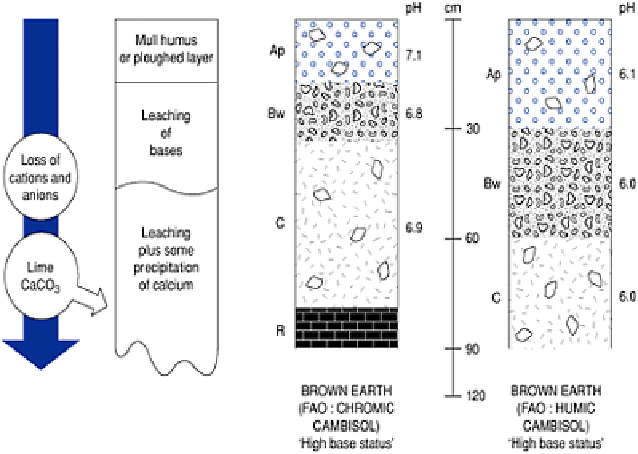Environmental Engineering Reference
In-Depth Information
zone) are able to recycle nutrients from deep in the subsoil and thus act as a kind of
'nutrient pump'. Shallow-rooting species (e.g. coniferous trees and many heath plants)
are at a disadvantage and, other things being equal, will not be able to counteract leaching
losses as effectively. In farming practices, liming and fertilizer application are used in
order to balance both the leaching losses and the heavy withdrawal of nutrients by crop
yields. The French pedologist Duchaufour has coined the term
lixiviation
to designate the
process of chemical leaching.
Figure 19.6
Profiles of cambisols (brown earths).
The main soil profile formed by leaching is the brown earth soil (FAO Cambisol or
Phaeozem). The sequence of horizons is Ah-Bw-C-R, with Ah replaced by Ap where
ploughed (Figure 19.6 and Colour Plate 15 between pp. 400 and 401). The colour, texture
and pH of the soils vary with the type of parent material. Sandy textures can lead to a
'slight weathering-intense leaching' regime which produces low pH values in the range
4·0 to 5·5. In the past these brown earths were called 'low base status brown earths', in
order to distinguish them from 'high base status brown earths' on less acid parent
materials (e.g. basic igneous rocks, calcareous deposits). The acid variants have partially
decomposed litter (F and/or H horizon) at the soil surface with a thin eluvial Ea or Ae to
give a F-H-Ae-Bw- C-R sequence of horizons. On more basic parent materials the soils
have a strongly formed structure, a relatively high percentage base saturation and a high
cation exchange capacity, due to expanding clay minerals vermiculite and
montmorillonite. A variant has formed on ultrabasic rocks (e.g. on serpentines in
Scotland or the Lizard peninsula in England) in which magnesium is the dominant
exchangeable cation, often exceeding calcium by a factor of five, and in which the
contents of heavy metals such as nickel, chromium and cobalt are exceptionally high.
Pastures on these soils can give heavy-metal poisoning in cattle.

